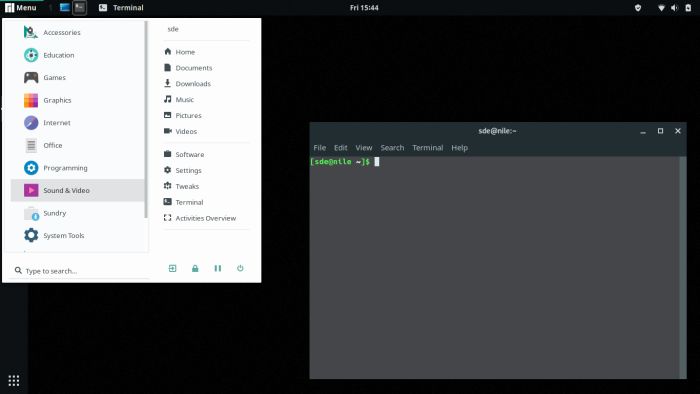Last Updated on December 7, 2022
GNOME is a desktop environment for Unix-like operating systems, composed entirely of free and open-source software. It provides a graphical user interface and a set of core applications, and the GNOME Development Platform, a framework for building applications that integrate with the desktop.
It’s the default desktop environment on many major Linux distributions including Fedora, Debian, Ubuntu, SUSE Linux Enterprise (exclusively), Red Hat Enterprise Linux, CentOS, Oracle Linux, Scientific Linux, SteamOS, Tails, Kali Linux, Antergos and Endless OS.
GNOME 3 lets you do the things you want without getting in the way. It won’t bother you or badger you with demands, and it has been designed to help you comfortably deal with notifications.
GNOME runs on Wayland and the X Window System.
- Focused working environment that helps you to get things done.
- Consistent and integrated experience. GNOME programs share a coherent style of graphical user interface (GUI).
- Dock.
- Activities.
- Search box.
- Calendar and Notifications area.
- Status menu
- Applications menu.
- Side-by-side windows makes it easy to view several documents at the same time.
- Seamlessly integrate with your online accounts, so that all your data can be accessed from the same place.
- GNOME Shell – the official user interface of the environment. It offers a top bar holding an Activities button, an application menu, a clock, and an integrated system status menu.
- Activities Overview – comes with a launcher-like favorites bar.
- Gnome Online Accounts – share data from online services. It supports many services including Google, Flickr, Facebook, Nextcloud and others.
- Built-in screencast recorder – start recording with Ctrl+Alt+Shift+R.
- A desktop environment physically and cognitively ergonomic for people with disabilities.
- Night Light – changes the color temperature.
Website: www.gnome.org/gnome-3
Support: Documentation, Wiki
Developer: The GNOME Project
License: GNU General Public License v2 or later

GNOME is written in a number of languages including C, XML, C++, C#, HTML, Vala, Python, and JavaScript.
Return to Desktop Environments Home Page
| Popular series | |
|---|---|
| The largest compilation of the best free and open source software in the universe. Each article is supplied with a legendary ratings chart helping you to make informed decisions. | |
| Hundreds of in-depth reviews offering our unbiased and expert opinion on software. We offer helpful and impartial information. | |
| The Big List of Active Linux Distros is a large compilation of actively developed Linux distributions. | |
| Replace proprietary software with open source alternatives: Google, Microsoft, Apple, Adobe, IBM, Autodesk, Oracle, Atlassian, Corel, Cisco, Intuit, and SAS. | |
| Awesome Free Linux Games Tools showcases a series of tools that making gaming on Linux a more pleasurable experience. This is a new series. | |
| Machine Learning explores practical applications of machine learning and deep learning from a Linux perspective. We've written reviews of more than 40 self-hosted apps. All are free and open source. | |
| New to Linux? Read our Linux for Starters series. We start right at the basics and teach you everything you need to know to get started with Linux. | |
| Alternatives to popular CLI tools showcases essential tools that are modern replacements for core Linux utilities. | |
| Essential Linux system tools focuses on small, indispensable utilities, useful for system administrators as well as regular users. | |
| Linux utilities to maximise your productivity. Small, indispensable tools, useful for anyone running a Linux machine. | |
| Surveys popular streaming services from a Linux perspective: Amazon Music Unlimited, Myuzi, Spotify, Deezer, Tidal. | |
| Saving Money with Linux looks at how you can reduce your energy bills running Linux. | |
| Home computers became commonplace in the 1980s. Emulate home computers including the Commodore 64, Amiga, Atari ST, ZX81, Amstrad CPC, and ZX Spectrum. | |
| Now and Then examines how promising open source software fared over the years. It can be a bumpy ride. | |
| Linux at Home looks at a range of home activities where Linux can play its part, making the most of our time at home, keeping active and engaged. | |
| Linux Candy reveals the lighter side of Linux. Have some fun and escape from the daily drudgery. | |
| Getting Started with Docker helps you master Docker, a set of platform as a service products that delivers software in packages called containers. | |
| Best Free Android Apps. We showcase free Android apps that are definitely worth downloading. There's a strict eligibility criteria for inclusion in this series. | |
| These best free books accelerate your learning of every programming language. Learn a new language today! | |
| These free tutorials offer the perfect tonic to our free programming books series. | |
| Linux Around The World showcases usergroups that are relevant to Linux enthusiasts. Great ways to meet up with fellow enthusiasts. | |
| Stars and Stripes is an occasional series looking at the impact of Linux in the USA. | |